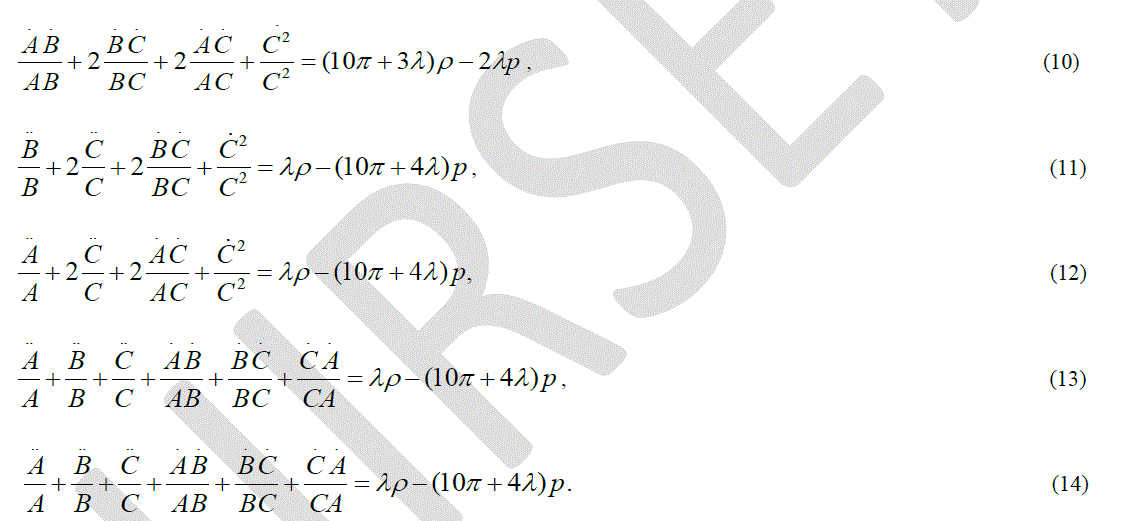ISSN ONLINE(2319-8753)PRINT(2347-6710)
ISSN ONLINE(2319-8753)PRINT(2347-6710)
L. S. Ladke1, V. K. Jaiswal2, R. A. Hiwarkar3
|
| Related article at Pubmed, Scholar Google |
Visit for more related articles at International Journal of Innovative Research in Science, Engineering and Technology
In this paper, we have obtained two five dimensional exact solutions of Bianchi type-I space-time in f (R,T) theory of gravity using assumption of constant deceleration parameter and variation law of Hubble parameter which correspond to two different cosmological models. The first solution yields a singular model for n  0while the second gives a non-singular model for n  0.The physical behavior for both the models have been discussed using some physical quantities..
KEYWORDS |
| f (R,T) theory of gravity, five dimensional Bianchi type-I space-time, Vacuum field equations. |
I. INTRODUCTION |
| Einstein general relativity is the basis to explain most of the gravitational phenomena but it does not seem to resolve some of the important problems in cosmology such as the accelerating expansion of the universe. It is now proved from observational and theoretical fact that our universe is in the phase of accelerated expansion. In order to explain the accelerated expansion, number of cosmological models have been proposed by different authors. f (T) theory of gravity where T is the scalar torsion has been proposed to explain current accelerated expansion without involving dark energy. Ratbay M. [1] has shown that the acceleration of the universe can be understood by f (T) gravity models. M. Sharif et al [2] considered spatially homogeneous and anisotropic Bianchi type–I universe in f (T) gravity theory. Wei H. et al [3] tried to constrain f (T) theories with the fine structure constant. Bamba K. et al [4] studied the cosmological evolution of the equation of state for dark energy with the combination of exponential, logarithmic and f (T) theories. f (R) theory of gravity is the another example of gravity. Many authors have investigated f (R) gravity in different contest. Carrolet. al. [5] explained the presence of late time comic acceleration of the universe in f (R) gravity. Nojiri and Odintsov[6,7] proved that the f (R) theory of gravity provides very natural unification of the early time inflation and late time acceleration. Bertolami et al [8] have poposed a generalization of f (R) modified theory of gravity, by including in the theory an explicit coupling of an arbitrary function of the Ricci scalar R with the matter Lagrangian density Lm. As a result of coupling the motionof the massive particles is non- geodesic and extra force orthogonal to the four velocity arises. Multamaki and Vilja [9,10] investigated static spherically symmetric vacuum solutions of the field equations and non- vacuum solutions by taking fluid respectively. Capozziello et al [11] used Noether symmetries to study spherically symmetric solutions in f (R) theory of gravity. Sharif and Shamir [12] studied exact vacuum solutions in Bianchi type-I and Vspace-times in f (R) ) theory of gravity. Shamir [13] discussed the plane symmetric vacuum Bianchi type-III cosmology in f (R) gravity. Aktas et al [14] have studied anisotropic models in f (R) gravity. Adhav [15] discussed the Kantawski-sachs string cosmological model in f (R) theory. Reddy et al [16] studied vacuum solutions of Bianchi type- I &V models in f (R) gravity with a special form of deceleration parameter. |
II. RELATED WORK |
 |
| Higher dimensional cosmological model play a vital role in many aspects of early stage of cosmological problems. The study of higher dimensional space- time provides an idea that our universe is much smaller at early stage of evolution as observed today. There is nothing in the equation of relativity which restrict them to four dimensions. Kaluza and Klein [22, 23] have done remarkable work by introducing an idea of higher dimension space-time. Many researcherinspired to entered in to the field of higher dimension theory to explore knowledge of universe. Wesson [24 ,25] and D.R. K. Reddy {26] have studied several aspects of five dimensional space-time in variable mass theory and bi-metric theory of relativity respectively. Lorentz and Petzold [27], Ibanez and Verdaguer [28] ,Khadekar and Gaikwad [29] ,Adhav et al [30] have studied the multidimensional cosmological models in general relativity and in other alternative theories of gravitations. Ladke L. S. [31] studied the Bianchi type-I (Kasner form) cosmological model in f(R) theory of gravity in five dimensions. |
| Motivating with the above research work we have obtained five dimensional exact solutions of Bianchi type-I space-time assuming constant deceleration parameter and variation law of Hubble’s parameter proposed by Berman M. S. [32] which corresponds to two different cosmological models. Physical aspects of both the models are also discussed. |
III. FIVE DIMENSIONAL FIELD EQUATIONS IN f (R,T) THEORY OF GRAVITY |
 |
 |
IV. EXACT SOLUTIONS OF BIANCHI TYPE-I SPACE TIME IN V5 |
| In this section we find exact solutions of five dimensional Bianchi type-I space time in f (R) theory of gravity. The line element of Bianchi type-I space-time in 5 V is given by |
 |
 |
 |
 |
 |
 |
 |
VIII. CONCLUSION |
 coefficients A,B, C and volume of the universe increase exponentially with the cosmic time. This shows that the universe expansion take place with zero volume from infinite past. It is seen that,the result obtained here are similar to the results obtained earlier by M. Farasat Shamir et. al (20). coefficients A,B, C and volume of the universe increase exponentially with the cosmic time. This shows that the universe expansion take place with zero volume from infinite past. It is seen that,the result obtained here are similar to the results obtained earlier by M. Farasat Shamir et. al (20). |
References |
|